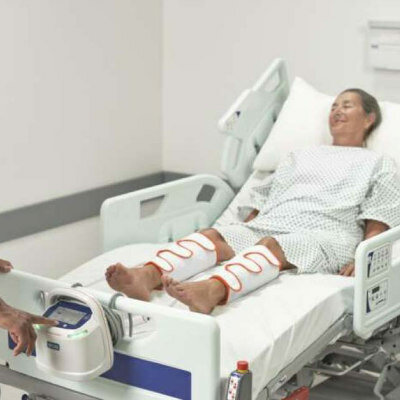Zika Infection in Pregnancy Linked to Joint Deformities
|
By HospiMedica International staff writers Posted on 25 Aug 2016 |

Image: An illustration of Zika virus in the blood (Photo courtesy of SPL).
A new study suggests that Zika virus infection during pregnancy may be related to a severe birth defect called arthrogryposis, wherein the joints are deformed.
Researchers at the Association for Assistance of Disabled Children (AACD; Recife, Brazil), the University of Pernambuco (UPE; Recife, Brazil), and other institutions in Brazil reported a retrospective case series study of seven children with arthrogryposis and a diagnosis of congenital infection (presumably caused by Zika virus) during the Brazilian microcephaly epidemic. The researchers described the clinical, radiological, and electromyographic features in the children, and examined the likely correlation between clinical and primary neurological abnormalities.
The results showed that brain images of all seven children were characteristic of congenital infection and arthrogryposis, with two of the children testing positive for IgM to Zika virus in the cerebrospinal fluid (CSF). Arthrogryposis was present in the arms and legs of six children (86%) and the legs of one child (14%). Hip radiographs showed bilateral dislocation in seven children, subluxation of the knee associated with genu valgus in three children (43%), which was bilateral in two (29%). All the children underwent high definition ultrasonography of the joints, and there was no evidence of abnormalities.
Five of the children also underwent brain computed tomography (CT) and magnetic resonance imaging (MRI), with the remaining two undergoing CT alone. All presented cortical development malformations and calcifications, predominantly in the cortex and subcortical white matter (especially in the junction between the cortex and white matter), reduction in brain volume, ventriculomegaly, and hypoplasia of the brainstem and cerebellum. MRI of the spine in four children showed apparent thinning of the cord and reduced ventral roots. The study was published on August 9, 2016, in BMJ.
“Congenital Zika syndrome should be added to the differential diagnosis of congenital infections and arthrogryposis. The arthrogryposis was unrelated to the abnormalities of the joints themselves, but was possibly of neurogenic origin, with chronic involvement of central and peripheral motor neurons leading to deformities as a result of fixed postures in utero,” concluded lead author pediatric neurologist Vanessa van der Linden, MD, of AACD, and colleagues. “Based on the neurophysiological observations, we suggest two possible mechanisms: tropism of neurons, with involvement of peripheral and central motor neurons, or a relation with vascular disorders.”
Arthrogryposis multiplex congenita is characterized by joint contractures at birth, which can be divided into isolated and multiple contractures. Isolated contractures affect only one area of the body, most commonly the foot. The term arthrogryposis is often used as shorthand to describe multiple congenital contractures affecting two or more areas of the body. Thus, arthrogryposis might be considered more a sign than a specific disease, and it might be associated with several disorders.
Zika virus is a member of the Flaviviridae family, of the genus Flavivirus, and is transmitted by daytime-active Aedes mosquitoes; in humans, the virus causes a mild illness known as Zika fever. Zika was first reported in Brazil in May 2015, and since then local health authorities estimate that around a million suspected cases have occurred. Brazilian health authorities also observed a significant increase in the number of detected cases of microcephaly and Guillain-Barré Syndrome affecting fetuses and newborns.
Related Links:
Association for Assistance of Disabled Children
University of Pernambuco
Researchers at the Association for Assistance of Disabled Children (AACD; Recife, Brazil), the University of Pernambuco (UPE; Recife, Brazil), and other institutions in Brazil reported a retrospective case series study of seven children with arthrogryposis and a diagnosis of congenital infection (presumably caused by Zika virus) during the Brazilian microcephaly epidemic. The researchers described the clinical, radiological, and electromyographic features in the children, and examined the likely correlation between clinical and primary neurological abnormalities.
The results showed that brain images of all seven children were characteristic of congenital infection and arthrogryposis, with two of the children testing positive for IgM to Zika virus in the cerebrospinal fluid (CSF). Arthrogryposis was present in the arms and legs of six children (86%) and the legs of one child (14%). Hip radiographs showed bilateral dislocation in seven children, subluxation of the knee associated with genu valgus in three children (43%), which was bilateral in two (29%). All the children underwent high definition ultrasonography of the joints, and there was no evidence of abnormalities.
Five of the children also underwent brain computed tomography (CT) and magnetic resonance imaging (MRI), with the remaining two undergoing CT alone. All presented cortical development malformations and calcifications, predominantly in the cortex and subcortical white matter (especially in the junction between the cortex and white matter), reduction in brain volume, ventriculomegaly, and hypoplasia of the brainstem and cerebellum. MRI of the spine in four children showed apparent thinning of the cord and reduced ventral roots. The study was published on August 9, 2016, in BMJ.
“Congenital Zika syndrome should be added to the differential diagnosis of congenital infections and arthrogryposis. The arthrogryposis was unrelated to the abnormalities of the joints themselves, but was possibly of neurogenic origin, with chronic involvement of central and peripheral motor neurons leading to deformities as a result of fixed postures in utero,” concluded lead author pediatric neurologist Vanessa van der Linden, MD, of AACD, and colleagues. “Based on the neurophysiological observations, we suggest two possible mechanisms: tropism of neurons, with involvement of peripheral and central motor neurons, or a relation with vascular disorders.”
Arthrogryposis multiplex congenita is characterized by joint contractures at birth, which can be divided into isolated and multiple contractures. Isolated contractures affect only one area of the body, most commonly the foot. The term arthrogryposis is often used as shorthand to describe multiple congenital contractures affecting two or more areas of the body. Thus, arthrogryposis might be considered more a sign than a specific disease, and it might be associated with several disorders.
Zika virus is a member of the Flaviviridae family, of the genus Flavivirus, and is transmitted by daytime-active Aedes mosquitoes; in humans, the virus causes a mild illness known as Zika fever. Zika was first reported in Brazil in May 2015, and since then local health authorities estimate that around a million suspected cases have occurred. Brazilian health authorities also observed a significant increase in the number of detected cases of microcephaly and Guillain-Barré Syndrome affecting fetuses and newborns.
Related Links:
Association for Assistance of Disabled Children
University of Pernambuco
Latest Patient Care News
- Revolutionary Automatic IV-Line Flushing Device to Enhance Infusion Care
- VR Training Tool Combats Contamination of Portable Medical Equipment
- Portable Biosensor Platform to Reduce Hospital-Acquired Infections
- First-Of-Its-Kind Portable Germicidal Light Technology Disinfects High-Touch Clinical Surfaces in Seconds
- Surgical Capacity Optimization Solution Helps Hospitals Boost OR Utilization

- Game-Changing Innovation in Surgical Instrument Sterilization Significantly Improves OR Throughput
- Next Gen ICU Bed to Help Address Complex Critical Care Needs
- Groundbreaking AI-Powered UV-C Disinfection Technology Redefines Infection Control Landscape
- Clean Hospitals Can Reduce Antibiotic Resistance, Save Lives
- Smart Hospital Beds Improve Accuracy of Medical Diagnosis
- New Fast Endoscope Drying System Improves Productivity and Traceability
- World’s First Automated Endoscope Cleaner Fights Antimicrobial Resistance
- Portable High-Capacity Digital Stretcher Scales Provide Precision Weighing for Patients in ER
- Portable Clinical Scale with Remote Indicator Allows for Flexible Patient Weighing Use
- Innovative and Highly Customizable Medical Carts Offer Unlimited Configuration Possibilities
- Biomolecular Wound Healing Film Adheres to Sensitive Tissue and Releases Active Ingredients
Channels
Critical Care
view channel
CPR Guidelines Updated for Pediatric and Neonatal Emergency Care and Resuscitation
Cardiac arrest in infants and children remains a leading cause of pediatric emergencies, with more than 7,000 out-of-hospital and 20,000 in-hospital cardiac arrests occurring annually in the United States.... Read more
Ingestible Capsule Monitors Intestinal Inflammation
Acute mesenteric ischemia—a life-threatening condition caused by blocked blood flow to the intestines—remains difficult to diagnose early because its symptoms often mimic common digestive problems.... Read more
Wireless Implantable Sensor Enables Continuous Endoleak Monitoring
Endovascular aneurysm repair (EVAR) is a life-saving, minimally invasive treatment for abdominal aortic aneurysms—balloon-like bulges in the aorta that can rupture with fatal consequences.... Read more
Wearable Patch for Early Skin Cancer Detection to Reduce Unnecessary Biopsies
Skin cancer remains one of the most dangerous and common cancers worldwide, with early detection crucial for improving survival rates. Traditional diagnostic methods—visual inspections, imaging, and biopsies—can... Read moreSurgical Techniques
view channel
Robotic Assistant Delivers Ultra-Precision Injections with Rapid Setup Times
Age-related macular degeneration (AMD) is a leading cause of blindness worldwide, affecting nearly 200 million people, a figure expected to rise to 280 million by 2040. Current treatment involves doctors... Read more
Minimally Invasive Endoscopic Surgery Improves Severe Stroke Outcomes
Intracerebral hemorrhage, a type of stroke caused by bleeding deep within the brain, remains one of the most challenging neurological emergencies to treat. Accounting for about 15% of all strokes, it carries... Read moreHealth IT
view channel
Printable Molecule-Selective Nanoparticles Enable Mass Production of Wearable Biosensors
The future of medicine is likely to focus on the personalization of healthcare—understanding exactly what an individual requires and delivering the appropriate combination of nutrients, metabolites, and... Read moreBusiness
view channel
Philips and Masimo Partner to Advance Patient Monitoring Measurement Technologies
Royal Philips (Amsterdam, Netherlands) and Masimo (Irvine, California, USA) have renewed their multi-year strategic collaboration, combining Philips’ expertise in patient monitoring with Masimo’s noninvasive... Read more
B. Braun Acquires Digital Microsurgery Company True Digital Surgery
The high-end microsurgery market in neurosurgery, spine, and ENT is undergoing a significant transformation. Traditional analog microscopes are giving way to digital exoscopes, which provide improved visualization,... Read more
CMEF 2025 to Promote Holistic and High-Quality Development of Medical and Health Industry
The 92nd China International Medical Equipment Fair (CMEF 2025) Autumn Exhibition is scheduled to be held from September 26 to 29 at the China Import and Export Fair Complex (Canton Fair Complex) in Guangzhou.... Read more







.jpg)






